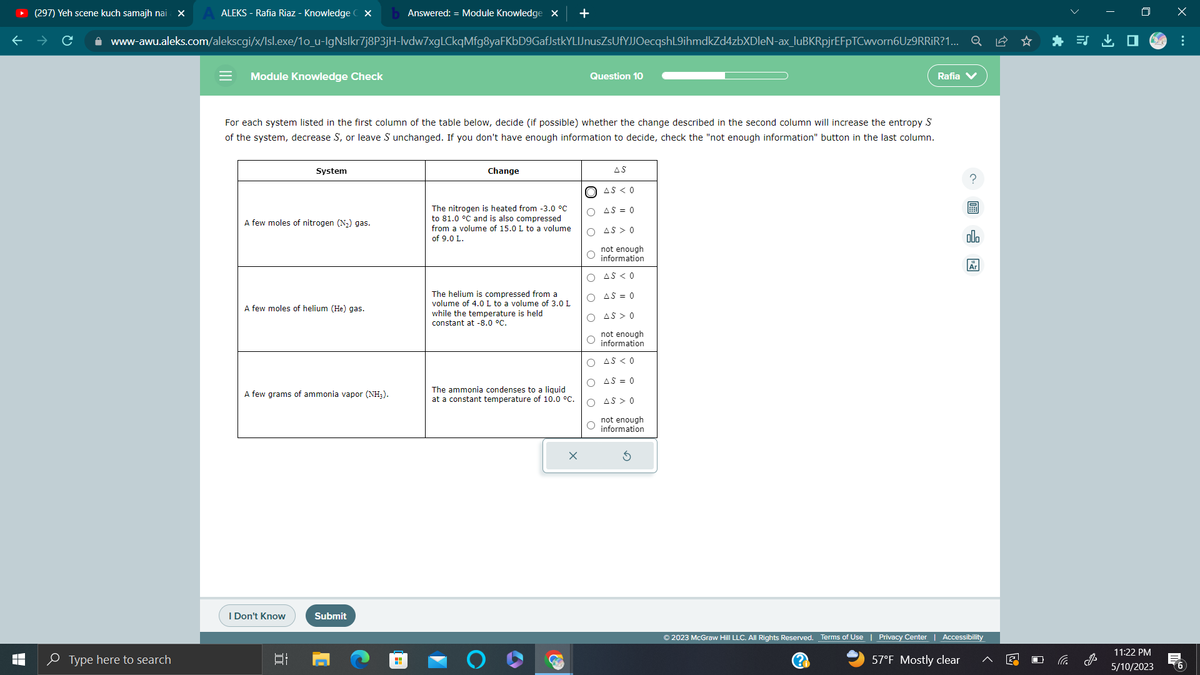For each system listed in the first column of the table below, decide (if possible) whether the change described in the second column will increase the entropy S of the system, decrease S, or leave S unchanged. If you don't have enough information to decide, check the "not enough information" button in the last column. System A few moles of nitrogen (N₂) gas. A few moles of helium (He) gas. A few grams of ammonia vapor (NH₂). Change The nitrogen is heated from -3.0°C to 81.0 °C and is also compressed from a volume of 15.0 L to a volume of 9.0 L. The helium is compressed from a volume of 4.0 L to a volume of 3.0 L while the temperature is held constant at -8.0 °C. The ammonia condenses to a liquid at a constant temperature of 10.0 °C. AS AS <0 - 45=0 AS >0 not enough information AS <0 AS=0 AS > 0 not enough information AS <0 O AS=0 AS >0 not enough information
For each system listed in the first column of the table below, decide (if possible) whether the change described in the second column will increase the entropy S of the system, decrease S, or leave S unchanged. If you don't have enough information to decide, check the "not enough information" button in the last column. System A few moles of nitrogen (N₂) gas. A few moles of helium (He) gas. A few grams of ammonia vapor (NH₂). Change The nitrogen is heated from -3.0°C to 81.0 °C and is also compressed from a volume of 15.0 L to a volume of 9.0 L. The helium is compressed from a volume of 4.0 L to a volume of 3.0 L while the temperature is held constant at -8.0 °C. The ammonia condenses to a liquid at a constant temperature of 10.0 °C. AS AS <0 - 45=0 AS >0 not enough information AS <0 AS=0 AS > 0 not enough information AS <0 O AS=0 AS >0 not enough information
Principles of Instrumental Analysis
7th Edition
ISBN:9781305577213
Author:Douglas A. Skoog, F. James Holler, Stanley R. Crouch
Publisher:Douglas A. Skoog, F. James Holler, Stanley R. Crouch
Chapter34: Particle Size Determination
Section: Chapter Questions
Problem 34.12QAP
Related questions
Question

Transcribed Image Text:T
LI
ALEKS - Rafia Riaz - Knowledge CX b Answered: = Module Knowledge X +
www-awu.aleks.com/alekscgi/x/lsl.exe/1o_u-IgNslkr7j8P3jH-lvdw7xgLCkqMfg8yaFKbD9GafJstkYLIJnusZsUfYJJOecqshL9ihmdkZd4zbXDleN-ax_luBKRpjrEFpTCwvorn6Uz9RRiR?1... Q
(297) Yeh scene kuch samajh nai X
Type here to search
= Module Knowledge Check
For each system listed in the first column of the table below, decide (if possible) whether the change described in the second column will increase the entropy S
of the system, decrease S, or leave S unchanged. If you don't have enough information to decide, check the "not enough information" button in the last column.
A few moles of nitrogen (N₂) gas.
System
A few moles of helium (He) gas.
A few grams of ammonia vapor (NH₂).
I Don't Know
Et
Submit
Change
The nitrogen is heated from -3.0 °C
to 81.0 °C and is also compressed
from a volume of 15.0 L to a volume
of 9.0 L.
The helium is compressed from a
volume of 4.0 L to a volume of 3.0 L
while the temperature is held
constant at -8.0 °C.
The ammonia condenses to a liquid
at a constant temperature of 10.0 °C.
3
Question 10
X
AS
AS < 0
O AS = 0
O AS > 0
not enough
O information
O AS < 0
O
AS = 0
O AS > 0
not enough
O information
O AS < 0
O AS = 0
O AS > 0
not enough
O information
Rafia
?圖
ollo
© 2023 McGraw Hill LLC. All Rights Reserved. Terms of Use | Privacy Center | Accessibility
(?)
57°F Mostly clear
i
J
11:22 PM
5/10/2023
x
:
6
Expert Solution
This question has been solved!
Explore an expertly crafted, step-by-step solution for a thorough understanding of key concepts.
Step by step
Solved in 3 steps

Knowledge Booster
Learn more about
Need a deep-dive on the concept behind this application? Look no further. Learn more about this topic, chemistry and related others by exploring similar questions and additional content below.Recommended textbooks for you

Principles of Instrumental Analysis
Chemistry
ISBN:
9781305577213
Author:
Douglas A. Skoog, F. James Holler, Stanley R. Crouch
Publisher:
Cengage Learning

Principles of Instrumental Analysis
Chemistry
ISBN:
9781305577213
Author:
Douglas A. Skoog, F. James Holler, Stanley R. Crouch
Publisher:
Cengage Learning